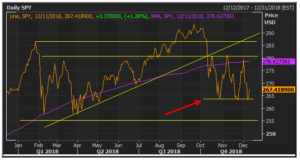In these volatile market environments, we are grateful for active investing.
One sign of a good running back in the NFL is the ability to quickly change directions to confuse the defense and elude being tackled. Just when the defense believes it has corralled the running back and has an opportunity to tackle him with little or no gain, he makes a quick stutter-step and races off in a different direction. Adrian Peterson, who plays for the Washington Redskins, has shown that ability in his career. Le’Veon Bell of the Pittsburgh Steelers is particularly skilled at changing directions, which is why he is one of the premier running backs in the league today. (Despite the fact that he is not playing this year due to a contract dispute—but that is a subject for another day.)
Watching some football games recently, it occurred to me that the stock market has exhibited the same kind of behavior this year. Just when it appeared to be building momentum in one direction, it has quickly reversed course and headed off in the opposite direction, frustrating investors and traders alike.
On average, the stock market gains about 0.5% per month (looking back over 40 years). In January, the S&P 500 index rose almost 6% (the best one-month gain in nearly three years). Then, in February and March, the index suddenly changed course and fell more than 7%. In the third quarter, stocks rose almost 8% (the best quarterly return in two years), only to fall nearly 7% in October.
And it isn’t just the month-to-month returns that are flip-flopping so quickly. We are seeing this action within a single month. In November, stocks rose nearly 4% in five days, then fell abruptly more than 6% over the next two weeks, before rallying again by 5% to close out the month. It’s enough to make any investor nauseous, trying to follow these herky-jerky movements.
This type of behavior by stocks does occur at times. We have been spoiled by the smooth performance of stocks in 2017 when the S&P 500 index did not have a single down month. That has made the volatility during 2018 seem magnified because it has been a while since we have gone through a rough patch.
The recent volatility has been tied primarily to concerns about the Federal Reserve’s continuing increase of interest rates and the trade spat with China. In late November, it appeared that the news on both of these fronts was positive, which fueled the market’s strong finish as the month ended. Now, as we move into December, investors are more worried about global growth in general, which is to say, they are concerned that the slowdown in growth may be great enough to stir thoughts of recession.
What is the impact of this volatility on the FSA portfolios?
As you probably noticed, we built up our money market position during the October sell-off. As stocks have see-sawed since then, we have kept the balanced strategies more defensive, including Income & Growth (about 10% in equities) and Conservative Growth (between 20% and 30% in equities). In the more aggressive strategies (Core Equity and Tactical Growth), we have a higher allocation to equities—around 50%.
We are monitoring the FSA Safety Nets® daily to see which of the remaining stock and bond funds may be triggered. While each fund has its own price target, to give you an idea how close we are to selling all the remaining stock funds out of the portfolios, the exit point for the S&P 500 index is just below current levels (see red arrow on the chart above).
With stocks darting up and down from week to week (and sometimes daily), we are trying to remain focused on the longer term direction. Seasonal trends would suggest a positive outcome for stocks in the final month of the year, but the recent action of stocks puts that rosy historical tendency in jeopardy. Any further weakness will bring the defense completely out on the field.
Closing Thoughts
As a final reminder, most mutual funds will be paying their year-end distributions before year-end. When a fund pays its distribution, expect the price to drop to reflect that payment. Once the proceeds are reinvested into your account (usually the next day), the fund’s value will increase back to normal.
On another note, it was interesting to watch some of the eulogy for George H.W. Bush recently. Whatever your political persuasion, it was refreshing to hear how he supported his views and party while maintaining civility towards his opponents. And of course, his devotion to family and relationships with his friends should be an inspiration to us all.
If you wish to discuss your portfolio or if there are any changes in your personal situation, please contact your advisor.
Finally, we want to wish everyone all the blessings and joys of this season and hope that your new year is filled with hope and prosperity.
Ronald Rough, CFA®
Director of Portfolio Management
Disclosures: Please remember that past performance may not be indicative of future results. Different types of investments involve varying degrees of risk, and there can be no assurance that the future performance of any specific investment, investment strategy, or product (including the investments and/or investment strategies recommended or undertaken by Financial Services Advisory, or any non-investment related content, made reference to directly or indirectly in this newsletter) will be profitable, equal any corresponding indicated historical performance level(s), be suitable for your portfolio or individual situation, or prove successful. Due to various factors, including changing market conditions or applicable laws, the content may no longer be reflective of current opinions or positions.
The FSA Safety Net® is designed to represent an exit point for each security within a portfolio and to help reduce losses from sustained drops in the financial markets. The FSA Safety Net® is not effective and will not protect assets in abrupt/sudden market drops. Examples of such occurrences include, but are not limited to, the market crash of October 1987, the market drop in October 1989, the market disruption caused by the terrorist attacks of September 2001, and the flash crash of May 2010. Similar future occurrences could reduce the effectiveness of the FSA Safety Net®. In addition, the FSA Safety Net® will not protect assets in the event mutual fund companies, custodial companies, or the securities exchanges themselves, at their discretion, suspend, disallow, or fail to conduct trades, redemptions, or liquidations.
Inverse/Enhanced investments: FSA may utilize inverse (short) mutual funds and/or exchange-traded investments/funds (ETFs) that are designed to perform in an inverse (opposite) relationship to certain market indices (at a rate of one or more times the inverse result of the corresponding index). In addition, FSA may also use leveraged (enhanced) mutual funds or ETFs that provide an enhanced relationship to certain market indices (at a rate of more than one times the actual result of the corresponding index). There can be no assurance that any such investment will prove profitable or successful. In light of these enhanced risks/rewards, clients may direct FSA, in writing, not to employ any or all such investments.
Moreover, you should not assume that any discussion or information contained in this newsletter serves as the receipt of, or as a substitute for, personalized investment advice from FSA.
Financial Services Advisory is neither a law firm, accounting firm nor insurance agency and no portion of this newsletter should be construed as legal, tax, insurance or accounting advice. FSA advisors are not attorneys, accountants, insurance agents or comprehensive financial planners and no portion of its services should be construed as legal, accounting, insurance, or tax advice.
For further details, including FSA’s current Disclosure Brochure discussing our advisory services and fees, please see important disclosures at www.FSAinvest.com/disclosure. The scope of the services to be provided depends upon the needs of the client and the terms of the engagement.
Please remember that it remains your responsibility to advise FSA, in writing, if there are any changes in your personal/financial situation or investment objectives for the purpose of reviewing/evaluating/revising our previous recommendations and/or services, or if you would like to impose, add, or to modify any reasonable restrictions to our investment advisory services.





